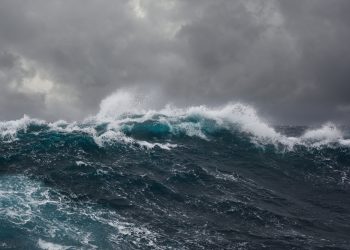 Royal Dutch Shell PLC has been given a permit to begin preparation work at exploratory drilling sites in the Chukchi Sea off Alaska’s northwest coast while it awaits certification for its oil spill response barge, Interior Secretary Ken Salazar announced Thursday.
Royal Dutch Shell PLC has been given a permit to begin preparation work at exploratory drilling sites in the Chukchi Sea off Alaska’s northwest coast while it awaits certification for its oil spill response barge, Interior Secretary Ken Salazar announced Thursday.
“We are allowing certain limited preparatory activities that we know can be done in a safe manner,” he said in a teleconference with reporters.
The company was granted permission to starting digging with its drill ship, but only into the layer of ocean bottom that’s above oil reserves. Shell can dig 20-by-40-foot mud-line cellars, which will eventually hold and protect a well’s blowout preventer 40 feet below the seabed. The company also is authorized to drill narrow pilot holes, which reveal obstructions or gas pockets, down another 1,500 feet. That’s about 4,000 feet above were petroleum is expected.
“These activities are essential safety steps that will allow for the installation and protection of the blowout preventer,” Salazar said.
The limited work will be conducted with Bureau of Safety and Environmental Enforcement safety experts present 24 hours a day, Salazar said. The decision followed exhaustive review of Shell drilling rigs and safety equipment including a capping stack that could be lowered onto a leaking well, Salazar said.
Shell remains prohibited from drilling deeper into petroleum-bearing formations until it meets other requirements, including Coast Guard certification of an oil spill response barge that remains in port in Bellingham, Wash.
“That’s period, end of story,” Salazar said.
Federal regulators are requiring Shell to suspend drilling in the Chukchi 38 days before ice moves in, to make sure the company has time cope with a spill or a wellhead blowout. That means drilling would have to stop around Sept. 24.
Shell this month asked to extend that deadline for two weeks, saying new data indicates ice will not be a factor until mid-November. Salazar said a decision on an extension is unnecessary until Shell completes work on its response barge.
Shell hopes to drill exploratory wells in both the Chukchi and Beaufort seas during this year’s open water season, which is rapidly drawing to a close.
“We don’t know what’s going to happen with Shell and whether they’re going to be able to complete a well this year,” Salazar said. “The situation remains dynamic.”
At a news conference Thursday afternoon, Shell Alaska Vice President Pete Slaiby said employees cheered Salazar’s announcement, even as he acknowledged that completing a well in the Chukchi without the extension would be “very, very difficult.”
The spill response barge could be certified next week, but towing it to the drilling area would take upward of two weeks.
Drilling a mud-line cellar and a pilot hole, he said, could start next week and take about two weeks. Continuing to the hydrocarbon-bearing zone at about 4,500 feet would take another two weeks.
Completing preliminary work, he said, would make 2012 a success even without drilling into the hydrocarbon zone.
“All this work on top holes is clearly going to help us as well, put wind in our sails for 2013,” he said.
Environment groups condemned the decision. Margaret Williams of World Wildlife Fund said technology does not exist to contain a spill in the extreme Arctic Ocean environment.
“This is one of the most productive marine areas in the world, supporting hundreds of species and thousands of people who depend on the sea’s bounty,” she said by email. “To drill in our Arctic Ocean is to gamble with its future.”
Source: Huffington Post



























































